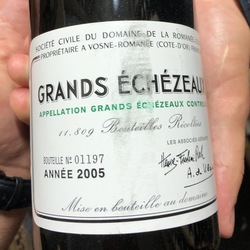Red Rhône Blend
Domaine Jean-Louis Chave
Hermitage Syrah 2004


Opus One
Napa Valley Cabernet Sauvignon Blend 1982
Decanted prior to service; enjoyed over the course of several hours. This bottle of the 1982 pours a deep garnet color with a near opaque core and some rim variation; medium viscosity with light staining of the tears and signs of sediment. On the nose, the wine is developing with a mix of tart, ripe and dried, mostly black fruits: cassis, blackberries, tobacco, dried flowers, grilled Poblano, leather, dry gravelly earth, and fine warm spices. On the palate, the wine is dry with medium+ tannin (integrated) and medium+ acid. Confirming the notes from the nose. The finish is medium+. One of the earliest vintages of Opus One, this is showing really well at the moment. Drink now through 2042. — 5 days ago
Château Haut-Brion
Pessac-Léognan Red Bordeaux Blend 1964
Decanted prior to service; enjoyed over the course of several hours. This bottle of the 1964 pours a garnet color with significant rim variation; medium viscosity with light staining and significant signs of sediment. On the nose, the wine is vinous with mostly tertiary notes at this point: cherry fruit leather, actual leather, decomposing log. On the palate, the wine is dry with tannin fully integrated and medium acid. Confirming the notes from the nose. The finish is medium. Alive…but this bottle is old and tired. Drink now. — 5 days ago
Château Lafite Rothschild
Pauillac Red Bordeaux Blend 2008
+2 hour decant(decent chunky/fine sediment). A remarkable dark magenta with some bricking. Nose: Captivating savory notes of dark fruit, herbaceous, funky earth, worn leather, pencil shavings, cedar, smoked meat, maybe a touch of bandaid(brett). Taste: A savory wine with class and elegance... dark currants, tobacco, graphite, saline, cedar, and a spiced earthy minerally medium plus finish. YUM! — 3 days ago

Château Mouton Rothschild
Pauillac Red Bordeaux Blend 1966
From back when Mouton was still a Second Growth. Decanted prior to service; enjoyed over the course of several hours. This bottle of the 1966 pours a garnet color with significant rim variation; medium viscosity with light staining and signs of sediment. On the nose, the wine is vinous with notes of ripe and desiccated red and black fruits: cassis, blackberries, green pepper, tobacco, leather, old wood, organic earth and warm spices. On the palate, the wine is dry with medium tannin and medium acid. Confirming the notes from the nose. The finish is medium. This was a good showing for the ‘66 and certainly has life left in it however, there’s no need to hold out. Drink now. — 5 days ago








Jay Kline

Presented to me double-blind. The wine pours a brilliant, deep ruby color with a transparent core and some rim variation; medium+ viscosity with moderate staining of the tears and faint signs of sediment. On the nose, the wine is developing with a heady perfume of mostly ripe and some tart fruit: mixed brambles, black cherry, purple flowers (lavender?), animale, some pepper, a touch of olive, a touch of leather, some green herbs, fine warm spices and rocky earth. I believe this has seen oak and it’s beautifully balanced and smells expensive. On the palate, the wine is dry with medium+ tannin and medium+ acid. Alcohol is medium+. Confirming the notes from the nose. The finish is long and the texture is grippy. This is delicious.
Initial conclusions: this could be Sangiovese, Pinot Noir, Gamay, a Grenache-based blend or possibly Syrah; from Italy, or France. Immediately after I was presented the glass, I liked this being Sangiovese, however, there was too much new French oak for me to feel comfortable. Besides, the florals were too purple to be Sangiovese anyway (never mind Grenache or Pinot Noir). Then there were the non-fruits: it could be justified by whole cluster Pinot or Gamay…or was this a really impressive Syrah? This wine seemed familiar to me. This could be Chave. I did think this had some age based on color and rim variation. Final conclusion: I’m calling this Syrah, from France, from Northern Rhône, Hermitage, with 20+ years of age, from a decent vintage like 2004. And for the hell if it, I called producer: Jean-Louis Chave. Boom. Bottle No. 3981 — 5 days ago